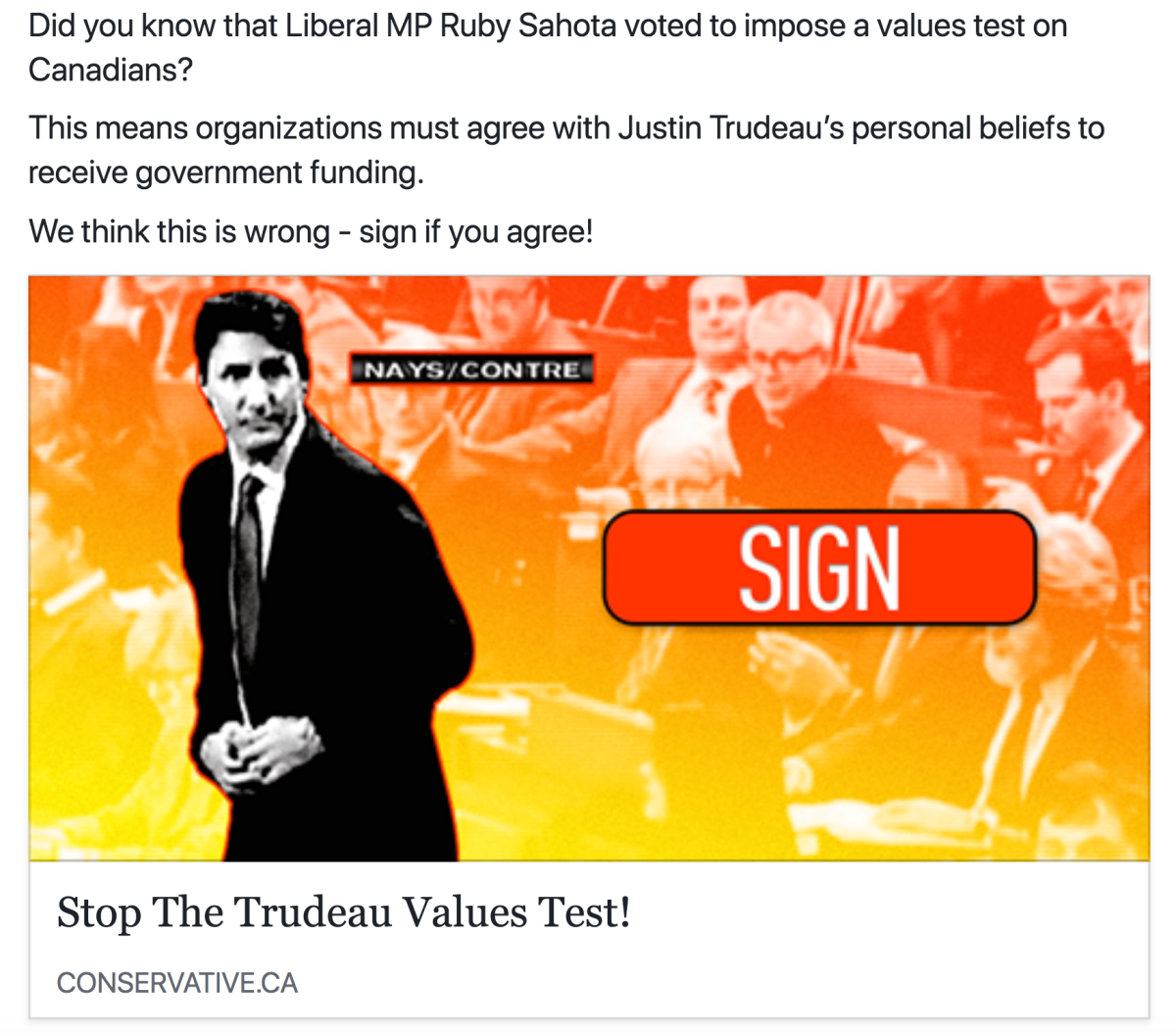As veteran political journalist Susan Delacourt detailed in her book Shopping for Votes, Canada’s political parties — like parties around the world — have been making heavy use of Facebook for years to find supporters, engage with them and encourage them to vote, volunteer and donate.

Facebook’s value to political parties (and other advertisers) is that it can help find potential supporters based on all that personal information Facebook users give to Facebook as they use the platform.
Did you tell Facebook you went to a university? Well, the higher the degree, the greater the chance you’re likely to support the Liberal Party of Canada.
Did you give Facebook your birthday? Did you tell it your gender? We know from any number of polls that support for the Conservatives is highest among older men.
WATCH: Liberals slam Conservatives for 240 Facebook ads to attack 16 MPs

With just three basic bits of demographic data like that, Facebook can help the Liberal Party find Liberals and the Conservative Party find Conservatives.
But, of course, Facebook knows much more about its users. It knows what we “Like” and what we’re interested in. Then it’s up to the parties themselves to learn more about their supporters so they can find more supporters. For example, several years ago, a Conservative cabinet minister told me his party had discovered that there was a huge probability that fans of World Wrestling Entertainment events were also most likely to vote Conservative. And so the party, in its purchase of Facebook ads, started filling up the feeds of WWE fans.
Facebook also has a pretty good idea of where its users live.
As a result, political parties tailor different advertising messages for different kinds of users. An elderly male Sikh truck driver in Surrey, B.C., will likely see a different ad, perhaps in a different language, than a young female agnostic arts administrator in downtown Montreal.
For a long time, it was difficult for reporters or any other observer to get a sense of the different messages parties were using for these different groups. No longer.
Facebook now has a feature that lets you look at all the ads that any political party (or any person or organization that runs a Facebook “Page”) is currently running. You can’t dig up old ads. You can only see ads that are running across Facebook’s network right now.
Still, for political observers, frequent checks of a party’s ad set can give us some insights into some party strategies.
All three major federal parties — the Liberals, Conservatives and NDP — were running an ad set on Thursday morning. Individual ads in that set would be keyed to display to different kinds of Facebook users.
The smallest ad set Thursday was from the NDP. Its ad set had just four ads in it. The Liberals had 25 ads in its ad set and the Conservatives had a whopping 247 ads. You won’t be surprised to learn that the Conservatives are easily the wealthiest of the three parties and they don’t let that money sit in the bank. It’s out there working on Facebook. The NDP is the poorest of the three parties and spends less on Facebook advertising.
Individual politicians also engage in Facebook advertising. NDP Leader Jagmeet Singh, for example, has 178,000 people following him on Facebook alone, while the page for the party he leads has just 109,000 followers. Singh’s page, incidentally, had a two-ad set running Thursday morning versus the party’s four-ad set.
Speaking of money, none of the ads from any of the parties on Thursday morning were seeking donations. That’s not always the case. Instead, all of the ads up Thursday morning simply encouraged a viewer to click through to sign up, sign a petition, “learn more” or, in the case of the Liberals, attend their bi-annual convention next month in Halifax. All parties were looking for a viewer to “Like” or provide an e-mail address or other personal information. That helps parties find voters and supporters.
Both the Liberals and the NDP were running ads Thursday in both official languages. But all 247 ads in the Conservative set were in English.
“We’re constantly tweaking our ad sets every day. What you see one day, you may not the next,” Conservative spokesman Cory Hann told me when I asked him about this. “I wouldn’t put too much weight in what you find over one day pointing to any particular strategy for those reasons.”
Indeed, a few hours after Hann told me this, a French-language ad, one attacking the budget, was part of the Conservative ad set.
Some other notes about Thursday’s ad sets (ad sets were current as of about 0830 ET on March 22).
- Of the 247 Conservative ads, 240 of them attack 16 different Liberal MPs by name for supporting what the Conservatives call “Trudeau’s values test” — the rule, put in place by the Trudeau government that organizations applying for federal summer job grants had to affirm that they supported a woman’s right to choose. All of those Liberals represent ridings in Ontario or New Brunswick. Every one of those Liberals is a first-time MP holding a riding that was held by the Conservatives prior to the 2015 election. It’s a fair conclusion that these are among the ridings the Conservatives believe they’ll have to win back to form a government.
- The 16 Liberal MPs singled out by the Conservatives are:
- New Brunswick: Matt DeCourcey (Fredericton), Pat Finnigan (Miramichi—Grande Lake), T.J. Harvey (Tobique—Mactaquac), Alaina Lockhart (Fundy Royal), Wayne Long (Saint John—Rothesay), Karen Ludwig (New Brunswick Southwest)
- Ontario: Mike Bossio (Hastings-Lennox and Addington), Francis Drouin (Glengarr—Prescott—Russell), Neil Ellis (Bay of Quinte), Kamal Khera (Brampton West), Bryan May (Cambridge), Karen McCrimmon (Kanata—Carleton), Bob Nault (Kenora), Ruby Sahota (Brampton North), Ramesh Sanga (Brampton Centre) Sonia Sidhu (Brampton South), Filomena Tassi (Hamilton West—Ancaster—Dundas)
- Why target New Brunswick MPs? One reason: Prime Minister Justin Trudeau was in New Brunswick Thursday, so if New Brunswickers fired up Facebook to catch pictures, video, or stories about the PM’s visit, they were likely going to see some of these Conservative attack ads.
- Only one Conservative ad featured the party’s leader, Andrew Scheer. Of the 25 Liberal ads, Justin Trudeau was featured in 12. Trudeau is clearly his party’s biggest asset. Singh was featured in every NDP ad.
- While the “Trudeau values test” was the dominant theme Thursday for the Conservatives, the party was also running ads in support of the TransMountain pipeline expansion and against the federal budget. One ad warned viewers the Liberals will bring back the gun registry. Another noted that Trudeau is the only prime minister ever to have broken the law.
- All the NDP ads were about one theme: Tax fairness. That party believes corporations and the rich are not paying their fair share and that it’s too easy for tax cheats in Canada. Notably, that has been a theme that has featured prominently from NDP MPs during question period in the House of Commons. In fact, you will often see a party’s advertising strategy dovetail with their House of Commons question period strategy.







Comments